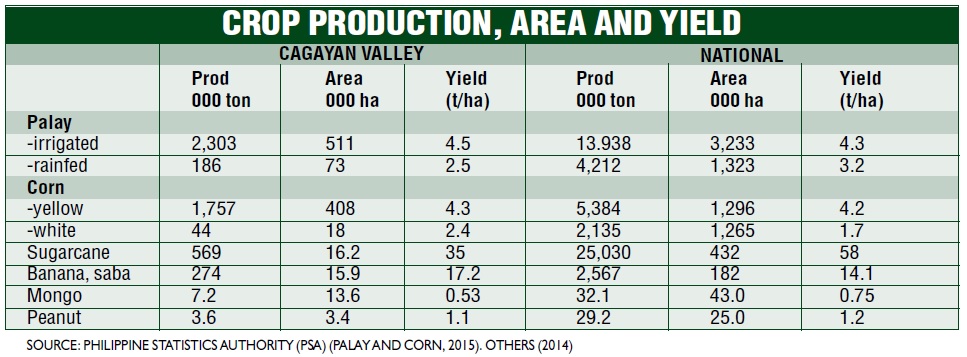Cagayan Valley, the granary region: where to?
Cagayan Valley (Region II) has five provinces: Batanes, Cagayan, Isabela, Nueva Vizcaya, and Quirino.
It has four cities: Cauayan, Ilagan, Santiago and Tuguegarao, the regional capital.
Its total population reached 3.45 million in 2015. Total employed in 2013 reached 1.48 million with agriculture at 846,000.
Region II is the second largest region of the Philippines in terms of land area with 2.83 million hectares (ha).
The total agriculture area is 540,800 ha with 437,000 ha under temporary crop, 56,000 ha under permanent crops, and 8,200 ha idle land.
I have visited the region in the past: Isabela, Cagayan and Nueva Vizcaya.
My first trip to Isabela was in 1985 to visit the Magat Dam, which serves some 85,000 ha of irrigated rice.
In 2009, it was my first visit to Tuguegarao, followed in 2010 in Reina Mercedes, Isabela, for the Corn Congress and to visit the huge corn processing center.
In 2012, I was in Bayombong and Solano, Nueva Vizcaya to look at the Nueva Vizcaya Agriculture Terminal.
In 2015, I took a 125-kilometer (km) land trip from Laoag to the fishing town of Claveria, Cagayan.
Major crops
Rice and corn are the main crops, with sugarcane and banana as distant third and fourth.
The region ranks first in the country in corn (24 percent share) and second in palay (14 percent).
The region is relatively productive in palay, corn and saba, but lags in sugarcane, peanut and mongo.
Key companies
Leading companies include Cagayan Robina Sugar Milling Company (CARSUMCO), Green Future Innovations, Mindanao Grains Processing Company, Universal Leaf Philippines, and SN Aboitiz-Magat Power.
CARSUMCO operates a sugar mill and refinery in Piat, Cagayan.
Green Future Innovations, a joint venture among Filipino, Japanese and Taiwanese partners, runs a bioethanol and cogeneration plant in San Mariano, Isabela.
It utilizes sugarcane and has a capacity of 200,000 liters per day or 54 million liters of anhydrous alcohol yearly. The cogen plant generates approximately 19 megawatts of power.
The growership program has 4,000 farmer families in Isabela. The plant operations provide employment for 15,000 workers.
Mindanao Grains Processing, which operates silos and dryers in Reina Mercedes, can serve up to 20,000 ha of corn areas.
Universal Leaf Philippines, a multi-national company, has a tobacco processing plant in Reina Mercedes. It does contract growing of burley tobacco in Isabela.
SN Aboitiz Power owns and operates the 360-megawatt (MW) Magat Hydroelectric Plant located at the border of Isabela and Ifugao.
The large rice mills include Valiant Rice Mills in San Mateo, Family Choice Grains Processing in Cabatuan, Golden Season Grains in Luna, Herco Agro Industries in Santiago City, JDT Silver Grains, New Cauayan Goldyluck Grains in Cauayan City and La Suerte Rice Mill in San Manuel. Several feedmills operate in the region.
In May 2015, the Department of Energy approved the service contract of the largest solar power plant in the country.
The 100-MW Solar project will help reduce the current shortage in electricity. It will be constructed at a 100-ha land in IIagan.
The region also hosts the Cagayan Special Economic Zone and Freeport, a special economic zone in Sta Ana. It is heavily underutilized.
Tourism
Tripadvisor listed eight leading destinations: Basco Lighthouse, Naidi Hills, Sabtang Beach (Batanes), Palaui Island, Callao Cave, Marlboro Hills (Mahatao), Anguib Beach (Sta. Ana), and Basilica of Our Lady of Piat (Tuguegarao).
Benham Rise is the newest fishing hub off the provinces of Aurora and Isabela.
The United Nations ruled in 2012 that the 13-million-ha, shallow expanse of sea belongs to the Philippines.
The strategic decision added 43 percent more to the Philippines’ total land territory.
Poverty incidence
The region had a lower poverty incidence than the national average in 2012. This has been on steady decline since 1991. However, at the provincial level, poverty incidence has declined in Cagayan and Isabela, but deteriorated in Batanes, Nueva Vizcaya and Quirino.
The Taiwan connection
Tuguegarao is only 570 km or 307 nautical miles to the southern city of Taiwan, Kaohsiung, and 825 km (446 nautical miles) to Taipei. Cagayan Valley is closer to Taiwan, than to Davao City. The trade and investment links though have yet to take root. Taiwan has the capital and technology, but it has a severe shortage of labor and land. Cagayan Valley is a natural partner.
Cagayan Valley must diversify. It must move up the value chains. These paths will provide more dynamism to its economy.
(The article reflects the personal opinion of the author and does not reflect the official stand of the Management Association of the Philippines or MAP. The author is the Vice Chair of the MAP AgriBusiness and Countryside Development Committee, and the Executive Director of the Center for Food and AgriBusiness of the University of Asia & the Pacific. Feedback at <[email protected]> and <[email protected]>. For previous articles, please visit <map.org.ph>)
















